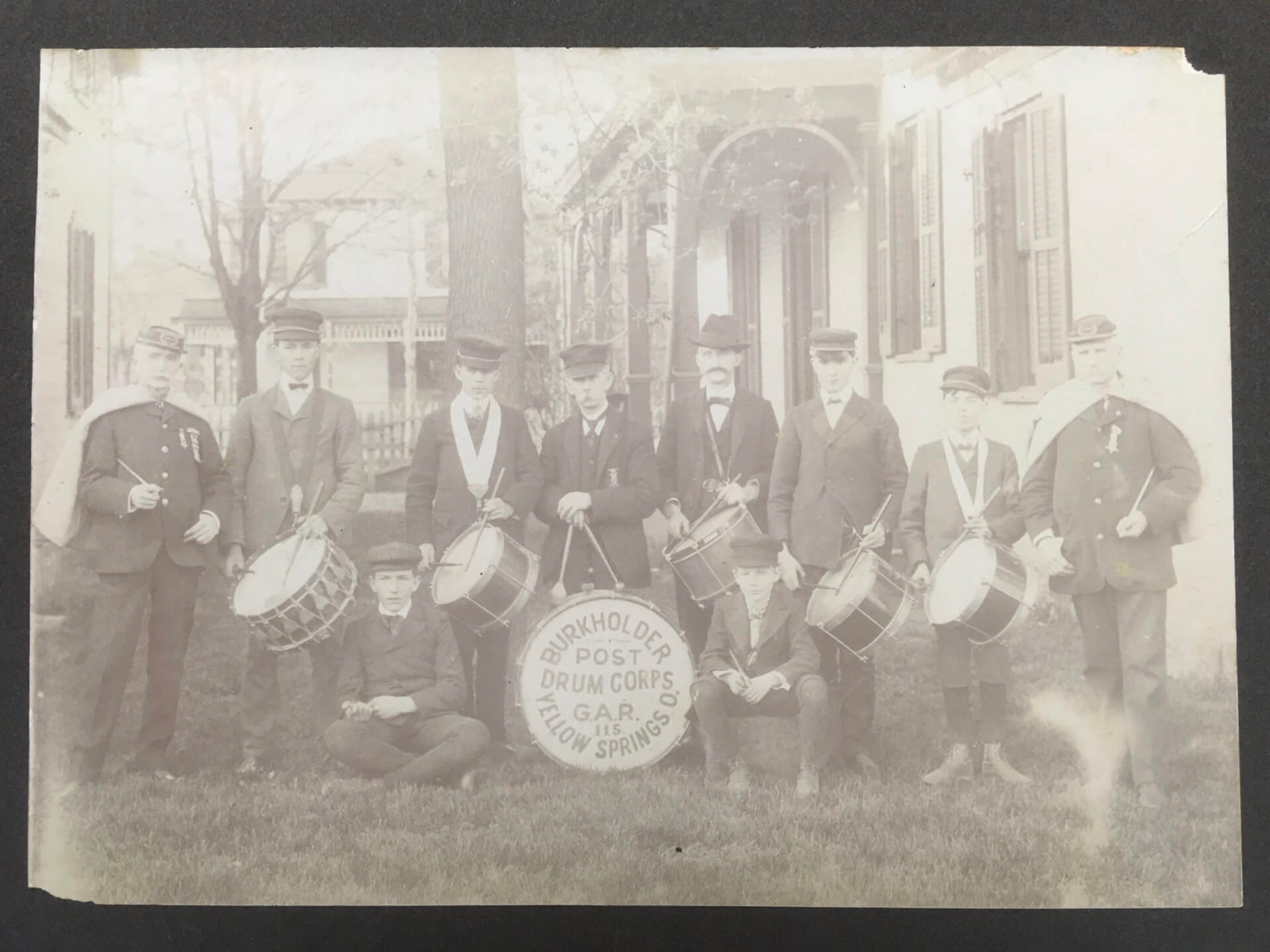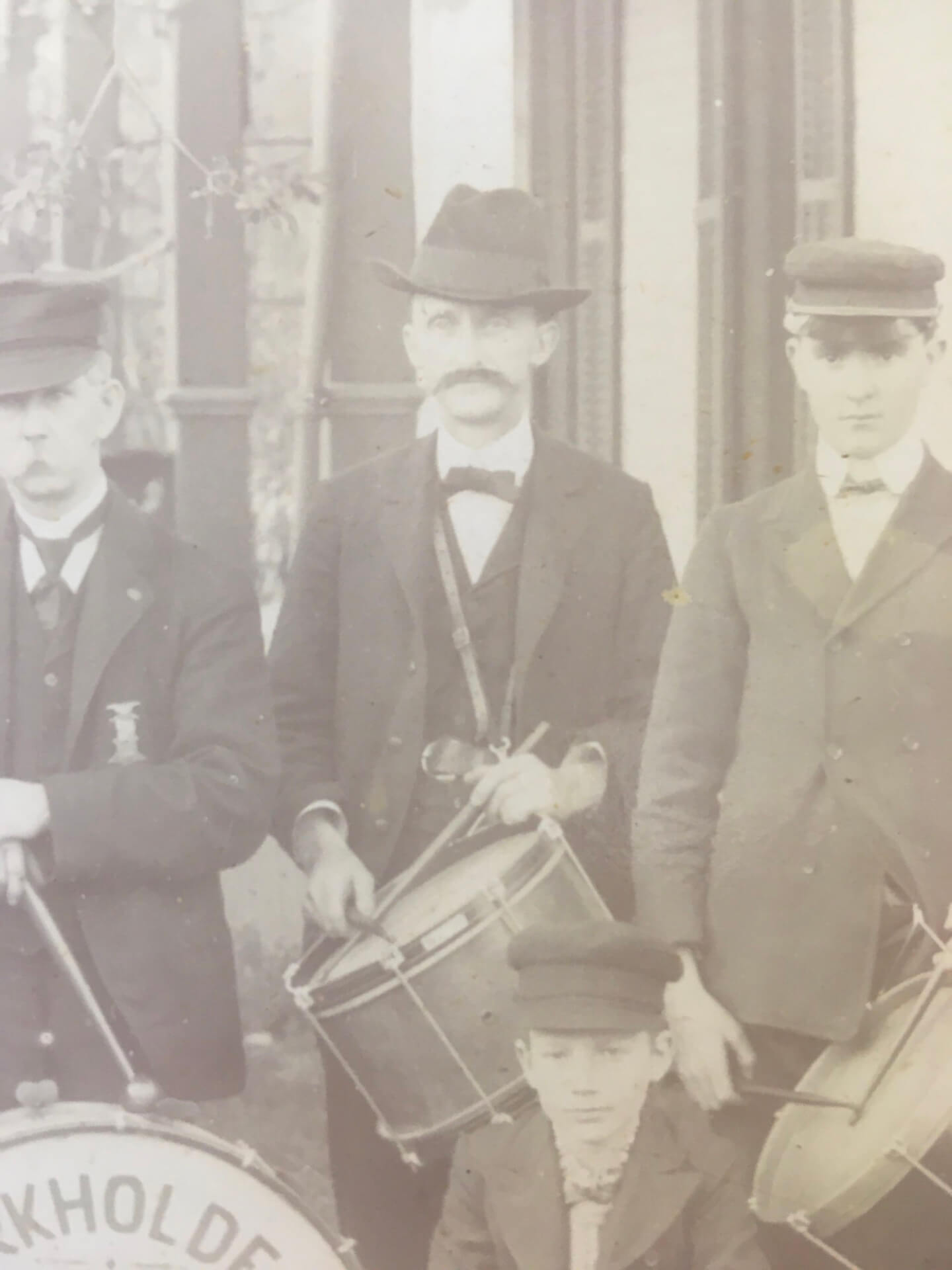
The Burkholder Post Drum Corps of Yellow Springs, OH poses together for a group photo. Among the men and boys is Denmore Duncan, the victim of this gruesome tale (standing fourth from the right). Photo courtesy of Scott Sanders.
The House of the Fiery Ferns
by Scott Sanders, Antioch College Archivist
Harold Igo, a playwright of some note, lived in Yellow Springs in the mid-20th century. He is said to have gathered stories of haunted houses in the village while serving as a part time mail carrier. He wrote up what he found out in a column for the Yellow Springs News called, not surprisingly, Haunted Houses. The first installment appeared in the February 4th issue of 1943, beginning with this note from the editor: “Mr. Igo frankly admits most of stories are based on nothing more definite than ‘hearsay’ and he does not vouch for the truth of any of them. But he says they interested him and he hopes they will do the same for NEWS readers.” Indeed the entire series is set aside in the files of Antiochiana, and almost none of them have much in the way of historical background that can be verified one way or another, except one: Haunted Houses #6, The House of the Fiery Ferns, which is reprinted below.
The story recounts the grisly murder of Denman Duncan, which happened 13 Sep 1915. Denman was the son Amos E. Duncan, an extraordinary man who taught physiology at Antioch College in the 1880s, served 20 years on its Board of Trustees, and was for much of that time its keeper of buildings and grounds. Amos had been a surgeon during the Civil War, gaining fame in that capacity certifying the death of a Confederate cavalry commander of legendary proportions named John Hunt Morgan. He had also saved the life of a man that expressed his gratitude with an endowed chair at the College that only Dr. Duncan would ever occupy, the Hoagland Professor of Physiology; upon Amos’ death in 1891, the position was never refilled.
Denman Duncan took courses at Antioch College 1874-1880, and was again enrolled briefly in the early 1890s, though never graduated. Igo paints him as something of a ne’er-do-well, implying for instance a drug addiction, most likely cocaine. His father, as a physician, would have likely had ample supplies on hand, as it was commonly used as an analgesic in the late 19th century. His residence might at least be some indication of the kind of life he was leading at the time, for the cottages along Yellow Springs Creek, last vestiges of a hotel called the Yellow Springs House (not the Neff Hotel as Igo reported, which was at the Yellow Spring), would have been in a distinctly rundown state by the nineteen teens.
Duncan’s neighbor and assailant, Lewis Haines, was a 46 year old laborer employed at Carr nursery, then one of the largest businesses in the village. The catalyst of the assault, his wife Maud Taylor, was twenty years younger than him, and according to the report from Xenia Police, theirs was a marriage fraught with domestic trouble. In the police report liberally quoted in the 17 Sep 1915 Xenia Daily Republican, Haines is described as “of almost insanely jealous disposition,” and Maud as having a “defiant nature,” although the childlike qualities Igo’s treatment confers upon her are not mentioned. In any event, it appears that theirs was a fairly volatile marriage, and that they quarreled frequently. Haines claimed in his confession that he had long detected “Duncan’s undue attentions” toward his wife, though it is unclear that any infidelity actually took place, and it is possible that Denman’s only real transgression was being in too close proximity to the Haines’ when their jealousies boiled over.
The facts of the case as reported at the time were these: After spending the day in Springfield at the circus so that Maud could see her first ever elephant, the Haines’ returned home at about 4:30 PM, where witnesses say they argued. Duncan left for the evening, and Haines, “brooding and angry” in his bed, is said to have heard Denman come home, whereupon Haines muttered that he was “going to kill the ____.” Maud testified to hearing the thud of a falling body and then a splash in a shallow pool behind the house. She then stated that her husband returned and “grunted in a mumbled tone” that he had killed him. Haines then washed and dried his hands before going back to bed, threatening to kill her if she breathed a word. There was however, far too much blood about the two apartments for any kind of cover-up.
Once confronted, Lewis Haines freely confessed “that he had crept, barefooted through the rear door of his rooms and walked in the open door at the rear of Duncan’s home. He found the hatchet inside the door near a pile of kindling. He stealthily made his way up behind his victim. Just as he had the hatchet raised above his head, Duncan emitted a sigh and placed the book over which he was pouring on a stand nearby.” In a truth-is-stranger-than-fiction twist, the book Denman was reading Les Misérables. Haines then struck Denman Duncan just above the temple, who then fell to the floor. Haines then tossed the weapon into the pool on his way back home. Duncan managed to open his front door before he died, much to the misfortune of the four year old boy who discovered the body the following morning.
In but a single run-on sentence, the affidavit for the crime filled in Xenia Mayor’s Court provides a tremendous example in the legal documentation of the time and the jargon employed:
“…one, Lewis Haines, then and there being, in and upon one Denman Duncan, then and there being, did unlawfully, purposely, and of deliberate and premeditated malice, make an assault in a menacing manner, with intent him the said Denman Duncan, unlawfully, purposely, and of deliberate and premeditated malice, to kill and murder; and with a certain hatchet, which he, the said Lewis Haines, in one of his hands then and there had and held he, the said Lewis Haines, him, the said Denman Duncan, in and upon the head of he, the said Denman Duncan, then and there being, then and there, unlawfully, purposefully and of deliberate and premeditated malice, did beat, curt, bruise ,and strike, with the intent aforesaid, thereby then and there giving him, the said Denman Duncan, one mortal wound of the length of three inches and the depth of two inches of which said mortal wound, he, the said Denman Duncan, then and there instantly died; and so the affiant, upon his oath aforesaid, says that the said Lewis Haines, him, the said Denman Duncan, in the manner and by the means aforesaid unlawfully, purposely, and of deliberate and premeditated malice, did kill and murder.”
The postscript of the Duncan murder is perhaps not as interesting as the crime itself, but far more significant: the owner of the cottages along the creek was local farmer John Bryan, whose land would become a state park that bears his name. Bryan concluded that the building was a nuisance, and soon looked to rid himself of it. Perhaps realizing that he could never get what it was worth after such an awful crime, his solution was to sell the land to the Village of Yellow Springs for one dollar. In exchange he stipulated that an educational institution be built on the property. In 1928 a lovely edifice called John Bryan High School (a community center since the 1970s) was completed.
Reprinted from the Yellow Springs News, 11 Mar 1943
Haunted Houses
by Harold Igo
No. 6, The House of the Fiery Ferns
Everybody liked Denman Duncan, even though he had the drug habit. Thirty years ago he was the son of an Antioch professor and he, himself, often took over his father’s classes in plant physiology. Between times he read a lot of books, studied nature in the glen and even did odd jobs for his neighbors such as painting and paper hanging. He lived in one of the little cottages that used to stand near the site of Bryan High School, the last remnant of the old Neff hotel.
In that row of cottages lived Lewis Hanes and his young wife. Hanes worked at Carr’s nursery. Now see how Fate brought these two men together.
Mrs. Hanes was considered by some as more of a child than a grown woman. She had always looked upon her husband with a certain awe such as a child regards its father. But when Denman Duncan became a neighbor of the Hanes she transferred her feelings from the Green House laborer to the educated naturalist.
One night she told her husband excitedly, “Oh, what do you think? Mr. Duncan has found forty different ferns in the Glen!”
“That fellow wouldn’t know a fern if he saw one,” growled Hanes.
“Oh, but he has read all about them in books,” said Mrs. Hanes, apparently much impressed.
“Book man, huh!” sneered Hanes. “I guess I work with ferns, don’t I? Skunk cabbage is all he’s ever found.” And so on.
Another night his wife had more news of Duncan. “I can’t wait to tell you,” she said, “Mr. Duncan has found a walking fern.”
“A what?” asked Hanes.
“A real walking fern.” But Lou Hanes didn’t wait to hear more.
He gulped down his coffee and went over to see Duncan. Denman was polishing up a walnut stool John Birch had lent him. “my wife says you…” and Lou stopped. He realized Duncan knew more about the fern than he did, had more book learning, so he twisted his remark, “says you were showing her that stool today.”
“Why, yes,” said Duncan innocently. “She stopped in and I showed it to her.”
“Huh,” snapped Hanes and disappeared.
Duncan considered it. Why, the fellow acted like he was jealous! That would never do. He decided to take the stool back first thing in the morning. And he did…
But that night…either from a desire to make her husband jealous or to dramatize her own lack of mature feminine attraction, the wife started the fern discussion again at the table.
“Oh Lou,” she began, “I must tell you the most wonderful thing. Mr. Duncan has found a new fern…one that shines at night…like a fire.”
“Foxfire,” growled Hanes.
“No, a real fern…like fire.”
Hanes got up from the table and went out again. But this time he had a hatchet in his hand. It was only a few steps on the back porch to Duncan’s door. He opened it softly. Duncan was sitting by a lamp reading. Like an Indian with a tomahawk, he sunk the hatchet into Duncan’s skull.
I heard at least five different versions of the Hanes-Duncan killing. But this story intrigued me the most. The fellow who told it said there was a legend that on a dark night if you stood on the culvert on the Springfield road and looked down the creek you might see an occasional gleam of light from Duncan’s phosphorescent ferns…I certainly can’t vouch for this but one of these dark nights I’m going to look.

Denmore Duncan (center) R.I.P.
